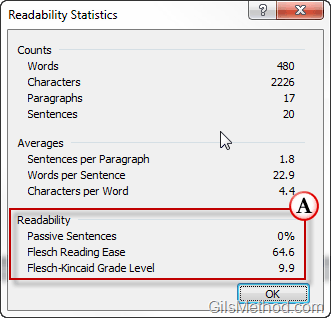

Mar 30, 2016 Microsoft Word and Outlook have long featured the ability to view “readability” statistics for what you’re writing, so you know how simple or complex you’re writing is. This can help ensure your writing is readable enough for your intended audience. In older versions of Word, the feature was just a click away on your status bar. Freelance copy editor Erin Wright shows how to add passive voice to Microsoft Word's grammar check and readability statistics. Freelance copy editor Erin Wright shows how to add passive voice to Microsoft Word's grammar check and readability statistics. MS is reporting that Windows users will have an update sometime in late August, and Mac.
To show the readability statistic, follow next steps:
1. On the File tab, click the Options button:
2. On the Proofing tab, make sure Check grammar withspelling is selected:
3. Under When correcting grammar in Word, select the Showreadability statistics check box.
After the grammar check is complete, Word displays a message box telling you that the checking has beencompleted:
Document statistics displayed in this dialog box include the number of characters, words, sentences, andparagraphs in the document. They also include the average number of sentences per paragraph, of wordsper sentence, and of characters per word.
Microsoft Word Readability Statistics
The readability of a document is often measured in terms of a grade level, and various algorithms can beused to estimate a document's ease of reading. The Readability Statistics dialog box includes theresults of three such commonly accepted estimates. The readability estimates in Word consist of thefollowing:
- Passive sentences, or the percentage of sentences written in the passive voice. Active voiceis considered to be more readable, so a high number of passive sentences means higher difficulty.
- Flesch Reading Ease, or readability based on the average number of syllables per word and theaverage number of words per sentence. Standard writing averages 60 to 70 on a 100-point scale. Thehigher the score, the more people can readily understand the document.
- Flesch-Kincaid Grade Level, or readability based on the average number of syllables per wordand the average number of words per sentence. This score indicates a grade school level. Forexample, a score of 6 means that a sixth-grader can understand the document. Standard writing isapproximately seventh- to eighth-grade level.
Last week’s post discussed the difference between active voice and passive voice. The steps below explain how to add passive voice to Microsoft Word’s grammar check and readability statistics.
This tutorial is also available as a YouTube video showing all the steps in real time.

Watch more than fifty other videos about Microsoft Word and Adobe Acrobat on my YouTube channel.
The images below are from Word 2013; however, these steps will work for Word 2019, Word 2016, and Word 2010.
For images from Word 2016, visit “How to Use the Passive Voice Tool in Word 2016.”
1. Select the File tab.
2. Select Options on the left-hand side of the Backstage view.
3. Select Proofing in the Word Options window.
4. Select Show readability statistics in the When correcting spelling and grammar in Word section.
5. Select Settings.
6. Select Passive sentences in the Grammar Settings window.
7. Click OK.
8. Select Recheck Document in the Word Options window if the document is already in progress. (This step isn’t necessary for blank documents.)
9. Select OK.
When you’re ready to run a grammar check:
Word Mac Readability Statistics
10. Select the Review tab.
Microsoft Word Readability Scale
11. Select Spelling & Grammar.
Mac Microsoft Word Readability Statistics Pdf
12. Change or ignore the results of your grammar check.
13. Review your passive sentence percentage in the Readability Statistics window. (This window won’t appear until you complete the grammar check.)
14. Select OK.
And now you know if your writing leans toward passivity or activity!